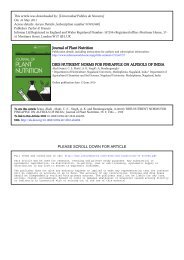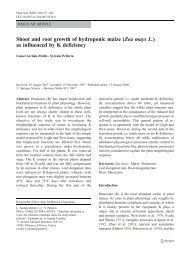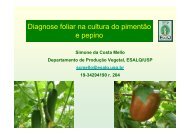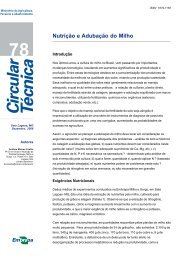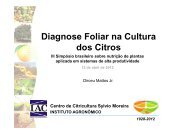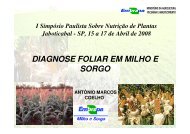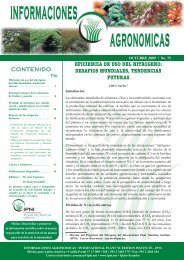Journal of Plant Nutrition - Nutricao de Plantas
Journal of Plant Nutrition - Nutricao de Plantas
Journal of Plant Nutrition - Nutricao de Plantas
Create successful ePaper yourself
Turn your PDF publications into a flip-book with our unique Google optimized e-Paper software.
This article was downloa<strong>de</strong>d by: [Universidad Publica <strong>de</strong> Navarra]On: 16 May 2011Access <strong>de</strong>tails: Access Details: [subscription number 936140347]Publisher Taylor & FrancisInforma Ltd Registered in England and Wales Registered Number: 1072954 Registered <strong>of</strong>fice: Mortimer House, 37-41 Mortimer Street, London W1T 3JH, UK<strong>Journal</strong> <strong>of</strong> <strong>Plant</strong> <strong>Nutrition</strong>Publication <strong>de</strong>tails, including instructions for authors and subscription information:http://www.informaworld.com/smpp/title~content=t713597277DIAGNOSIS AND RECOMMENDATION INTEGRATED SYSTEMAPPROACH FOR NITROGEN, PHOSPHORUS, POTASSIUM, AND ZINCFOLIAR DIAGNOSTIC NORMS FOR AONLA IN CENTRAL INDO-GANGETIC PLAINSA. K. Nayak a ; D. K. Sharma a ; C. S. Singh a ; V. K. Mishra a ; Gurbachan Singh a ; Anand Swarup aaCentral Soil Salinity Research Institute, Lucknow, IndiaOnline publication date: 06 February 2011To cite this Article Nayak, A. K. , Sharma, D. K. , Singh, C. S. , Mishra, V. K. , Singh, Gurbachan and Swarup, Anand(2011)'DIAGNOSIS AND RECOMMENDATION INTEGRATED SYSTEM APPROACH FOR NITROGEN, PHOSPHORUS,POTASSIUM, AND ZINC FOLIAR DIAGNOSTIC NORMS FOR AONLA IN CENTRAL INDO-GANGETIC PLAINS',<strong>Journal</strong> <strong>of</strong> <strong>Plant</strong> <strong>Nutrition</strong>, 34: 4, 547 — 556To link to this Article: DOI: 10.1080/01904167.2011.538116URL: http://dx.doi.org/10.1080/01904167.2011.538116PLEASE SCROLL DOWN FOR ARTICLEFull terms and conditions <strong>of</strong> use: http://www.informaworld.com/terms-and-conditions-<strong>of</strong>-access.pdfThis article may be used for research, teaching and private study purposes. Any substantial orsystematic reproduction, re-distribution, re-selling, loan or sub-licensing, systematic supply ordistribution in any form to anyone is expressly forbid<strong>de</strong>n.The publisher does not give any warranty express or implied or make any representation that the contentswill be complete or accurate or up to date. The accuracy <strong>of</strong> any instructions, formulae and drug dosesshould be in<strong>de</strong>pen<strong>de</strong>ntly verified with primary sources. The publisher shall not be liable for any loss,actions, claims, proceedings, <strong>de</strong>mand or costs or damages whatsoever or howsoever caused arising directlyor indirectly in connection with or arising out <strong>of</strong> the use <strong>of</strong> this material.
DRIS Norms for Aonla 551Downloa<strong>de</strong>d By: [Universidad Publica <strong>de</strong> Navarra] At: 09:30 16 May 2011DRIS indices as the quantitative evaluation <strong>of</strong> relative <strong>de</strong>gree <strong>of</strong> imbalance<strong>of</strong> the nutrients in this study can be calculated for the followingequations:Nin<strong>de</strong>x= [f(N/P) + f(N/K) + f(N/Zn)] / 3Pin<strong>de</strong>x= [−f(N/P) + f(P/K) + f(P/Zn)] / 3Kin<strong>de</strong>x= [−f (N/K)− f (P/K) + f(K/Zn)] / 3Zn in<strong>de</strong>x = [−f (N/Zn) − f (P/Zn) − (K/Zn)] / 3where( N/Pf(N/P) =)n/p − 1 x 1000CV( ) n/pf(N/P) =N/P − 1 x 1000CVwhen N/P > n/pwhen N/P < n/pSimilarly for the other functions, such as f (P/K) and f (K/Zn) were calculatedin the same way, using appropriate norms and CV.The leaf tissue optimum range for aonla plants were <strong>de</strong>termined by usingthe DRIS technique. In fact DRIS norms as reference values <strong>of</strong> each elementobtained from mineral composition <strong>of</strong> leaf tissues <strong>of</strong> the high yielding populationconstituted the mean <strong>of</strong> sufficiency. The optimum ranges are thevalues obtained from the mean ± 4/3 SD and mean ± 8/3 SD, respectively(Beaufils, 1971; Beaufils and Sumner, 1976; Bhargava, 2002). The nutrientvalues < (mean − 8/3 SD) measured <strong>de</strong>ficient, whereas their low range fallsincluding all value between > (mean − 8/3 SD) and < (mean − 4/3 SD).Values between > (mean − 4/3 SD) and < (mean + 4/3 SD) are consi<strong>de</strong>redas optimum. The range between > (mean + 4/3 SD) and < (mean +8/3 SD) were expressed as high. The leaf concentration > mean + 8/3 SDwere consi<strong>de</strong>red as toxic.RESULTS AND DISCUSSIONThe mostly soils <strong>of</strong> study area belong to three or<strong>de</strong>r (Inceptisol, Alfisoland Entisol). Mostly, the surface soil is fine loamy (55%), with small amountcoarse loamy (32%) and fine silty loam (12%). The surface soils <strong>of</strong> aonlaorchards are neutral (6.7 pH) to saline (9.3 pH) and range <strong>of</strong> electricalconductivity was 0.086 to 1.28 dS m −1 . Organic carbon content varied from0.14–0.87% with mean value <strong>of</strong> 0.54% and calcium carbonate (CaCO 3 )contentvaried from 3.24 to 11.4 g kg −1 with mean value <strong>of</strong> 8.52 g kg −1 . Theavailable N, Olsen’s P, and 1N NH 4 OAc extractable K was ranged from245–378 kg ha −1 , 16–28 kg ha −1 , and 58 to 251 kg ha −1 with mean value <strong>of</strong>310, 19 and 167 kg ha −1 , respectively (Table 2).Mean value <strong>of</strong> total N, P, K, and Zn content in leaves were found 1.87%,1.84%, 1.50%, 1.47%, 1.34%, and 0.10, 0.089, 0.079, 0.07, 0.079% and 0.68,
552 A. K. Nayak et al.TABLE 2 Soil properties <strong>of</strong> high yielding orchards <strong>of</strong> aonla plant <strong>of</strong> Central Indo-Gangetic plains <strong>of</strong>Uttar Pra<strong>de</strong>shSoil property Minimum Maximum Mean CV (%)pH (1:2) 7.65 9.52 8.76 18.5EC (dSm −1 ) 0.12 0.56 0.38 21.2Organic carbon (g kg −1 ) 0.14 0.57 0.34 16.2CaCO 3 (g kg −1 ) 3.24 11.4 8.52 34.6Available N (kg ha −1 ) 245 378 310 25.8Olsen’s P (kg ha −1 ) 16 28 19 21.2Available K (kg ha −1 ) 58 251 167 13.2Downloa<strong>de</strong>d By: [Universidad Publica <strong>de</strong> Navarra] At: 09:30 16 May 20110.798, 0.582, 0.527, 0.692% and 48.9, 50.2, 67.9, 45.4 and 36.5 ppm in theorchards <strong>of</strong> 5 yrs, 10 yrs, 15 yrs, 20 yrs and more than 20 yrs, respectively(Table 3). N, P and K and Zn contents in leaf samples were consi<strong>de</strong>rablyreduced with increasing the age <strong>of</strong> aonla tree where as no specific trend wasfound in Zn concentration. The <strong>de</strong>creased nutrient concentration in ol<strong>de</strong>rplants was partly due to increases in total biomass <strong>of</strong> plant and partly due topoor nutritional management <strong>of</strong> the old nursery by the farmers. However,with increases in the pH <strong>of</strong> the orchard soils (Table 4) there were <strong>de</strong>creases inthe nutrient contents in the aonla leaves. The N contents in leaves were 1.77,1.49, 1.48, 1.45, and 1.36% at pH 9.0, respectively.Similar trends were observed in respect to P, K and Zn concentration. Raoand Singh (2006) reported a <strong>de</strong>creased in nutrient content in aonla leaveswith increases in the soil sodicity. Maximum fruit yield <strong>of</strong> 40.2 kg plant −1was recor<strong>de</strong>d for the plans at the age group <strong>of</strong> 10–15 years and lowest yieldwas recor<strong>de</strong>d 28.3 kg plant −1 in the age <strong>of</strong> above 20 years (Table 3). Similarreducing trends <strong>of</strong> yield <strong>of</strong> aonla fruits were recor<strong>de</strong>d with increase in soilpH and lowest yield <strong>of</strong> 19.5 kg plant −1 yield was found at pH > 9(Table4).The DRIS norms recognized from N, P, K, and Zn composition <strong>of</strong> aonlaleaf samples were further employed to compute DRIS indices from the foliarcomposition <strong>of</strong> <strong>de</strong>clining anola plants <strong>of</strong> orchards in the plains <strong>of</strong> UttarPra<strong>de</strong>sh. As per DRIS indices obtained, the next <strong>of</strong> kin <strong>de</strong>ficiencies forTABLE 3 Mineral composition and DRIS indices <strong>of</strong> leaf samples <strong>of</strong> aonla plants collected from CentralIndo-Gangetic plains <strong>of</strong> Uttar Pra<strong>de</strong>shLeaf compositionDRIS indicesOrchardRequirement Yield kgage N (%) P (%) K (%) Zn ppm N P K Zn or<strong>de</strong>r plant −15 yrs 1.87 0.10 0.68 48.92 −924 1569 49 −695 N >Zn>K>P 29.810 yrs 1.84 0.089 0.798 50.2 −1491 −564 2479 −424 N>P>Zn>K 34.615 yrs 1.50 0.079 0.582 67.86 −5197 −1713 −1652 8562 N>P>K>Zn 40.220 yrs 1.47 0.07 0.527 45.43 −1249 −704 −413 2365 N>P>K>Zn 30.0>20yrs 1.34 0.079 0.692 36.54 −3719 1508 4463 −2252 N>P>K>Zn 28.3
DRIS Norms for Aonla 553TABLE 4 Effect pH on Mineral composition and DRIS indices <strong>of</strong> leaf samples <strong>of</strong> aonla plants collectedfrom Central Indo-Gangetic plains <strong>of</strong> Uttar Pra<strong>de</strong>shLeaf compositionDRIS indicespHRequirement Yield kgRange N (%) P (%) K (%) Zn ppm N P K Zn or<strong>de</strong>r plant −17.5–8.0 1.77 0.085 0.623 52.21 −75 −12 −0.93 87 N>P>K>Zn 38.58.0–8.5 1.49 0.072 0.69 51.43 −224 −106 189 140 N>P>Zn>K 34.48.5–9.0 1.48 0.065 0.625 45.87 −1661 −2441 1969 2132 P>N> K>Zn 26.5>−9.0 1.45 0.048 0.703 42.98 −460 −7784 5766 2477 P>N>Zn>K 22.3Downloa<strong>de</strong>d By: [Universidad Publica <strong>de</strong> Navarra] At: 09:30 16 May 2011each nutrient was i<strong>de</strong>ntified, DRIS indices specified requirements or<strong>de</strong>rs asN>P>K>Zn in mostly all age groups <strong>of</strong> plants. Nitrogen was found the mostlimiting elements in all age group <strong>of</strong> plant (Table 3). In the soil pH range8.5–9 and >9, P was found to be the most limiting element (Table 4); whereasN was limited at soil pH < 8.5. In addition to the diagnosis <strong>of</strong> <strong>de</strong>ficient nutrientsin the old senile aonla orchards <strong>of</strong> Uttar Pra<strong>de</strong>sh, the DRIS techniquealso gave the or<strong>de</strong>r <strong>of</strong> necessity for nutrients; however it was difficult to <strong>de</strong>termineif a relative nutrient toxic or <strong>de</strong>ficient <strong>of</strong> greater concern. Whencompared age wise, a relative <strong>de</strong>ficiency for N, P, and K corresponding torelative sufficiency for Zn was <strong>de</strong>tected by the DRIS technique for the plantsabove the age group <strong>of</strong> 15 onwards. For the younger orchards (5 yrs old) arelative <strong>de</strong>ficiency <strong>of</strong> N, Zn, and K corresponding to the relative sufficiency<strong>of</strong> P was <strong>de</strong>tected. When the DRIS indices were compared on basis <strong>of</strong> soilpH, Zn and K was found to be relatively less than N and P in regards to theor<strong>de</strong>r <strong>of</strong> requirement.The DRIS approach can also be employed to compute <strong>de</strong>ficient, low,sufficient, high and toxic ranges for nutrients. Sufficiency ranges <strong>of</strong> nutrients<strong>de</strong>rived from a nutrient in<strong>de</strong>xing survey <strong>of</strong> aonla fruit trees are shown inTable 5. The leaf composition interpretations <strong>of</strong> <strong>de</strong>ficient, low, sufficient,high and toxic level <strong>of</strong> each nutrient are <strong>de</strong>fined (Bhargava, 2002) as follows:Deficient: This indicates that the effective supply <strong>of</strong> the nutrient is so low thatthere is a reduction in growth, yield, and quality. Clearly visible <strong>de</strong>ficiencysymptoms, if they appear, indicate an acute shortage and imbalances <strong>of</strong> thenutrient in the plant.TABLE 5 Nutrient status <strong>of</strong> aonla fruit trees orchards in orchards from Central Indo-Gangetic plains <strong>of</strong>Uttar Pra<strong>de</strong>sh (%)Elements Deficient Low Sufficient High ToxicN (%) 26 34 33 7 —P(%) 8 22 51 19 —K(%) 1 18 47 31 3Zn (ppm) 17 27 46 9 1
554 A. K. Nayak et al.TABLE 6 Optimum ranges <strong>of</strong> elements <strong>de</strong>rived DRIS technique <strong>of</strong> aonla tree orchards from CentralIndo-Gangetic plains <strong>of</strong> Uttar Pra<strong>de</strong>shElement Mean S D Deficiet Low Sufficient High ToxicN (%) 1.468 0.129 1.81P (%) 0.073 0.014 0.11K (%) 0.518 0.091 0.76Zn (ppm) 39 5.219 52.9Downloa<strong>de</strong>d By: [Universidad Publica <strong>de</strong> Navarra] At: 09:30 16 May 2011Low: The supply <strong>of</strong> nutrient is ina<strong>de</strong>quate for the optimum productivity. Itinduces malnutrition symptoms and reduction in growth, yield and quality,which is some times referred to as hid<strong>de</strong>n hunger.A<strong>de</strong>quate: The growth, yield and quality <strong>of</strong> the tree are satisfactory, andthere is no need to make any changes in the schedule <strong>of</strong> manures andfertilizers. Changes in the nutrient concentration in the specified plant partdo not increase or <strong>de</strong>crease growth or production.High: Usually it represents the concentration in the leaf tissues betweena<strong>de</strong>quate and excessive range, which is more than necessary, leading to itsluxury consumption, nutrient imbalance, or <strong>de</strong>terioration in quality. Thenutrient application may be reduced.Excessive/toxic: when the concentration in the leaves reaches this level,serious abnormality in mineral metabolism is expressed. Definite toxicitysymptoms may occur for some nutrients and cause reduction in vigor, yieldand/or quality.The sufficiency range for nitrogen vary from 1.30–1.64% with an averagevalue <strong>of</strong> 1.47%. In the present study, it was observed that optimum values <strong>of</strong>P, K, and Zn ranged from 0.054–0.092%, 0.40– 0.64% and 32.4– 45.9 ppmwith mean values <strong>of</strong> 0.073%, 0.52%, and 39.1 ppm, respectively (Table 6).Thus, when interpreted with respect to sufficient nutrient concentrationranges, on the basis <strong>of</strong> leaf N-content in aonla tree, among all surveyedorchards 18%, 35%, 37%, 10%, and 0% plants were found Deficient, low,sufficient, high and toxic respectively. Whereas in case <strong>of</strong> P (8, 22, 51, 19and 0%), K (1, 18, 47, 31%), and Zn (3; 17, 27, 46, 9, and 1%) plantswere found <strong>de</strong>ficient, low, sufficient, high, and toxic ranges, respectively(Table 5). Accordingly, 53% <strong>of</strong> plants were found below sufficiency level <strong>of</strong>N. But in the case <strong>of</strong> K, only 19% <strong>of</strong> plants were below sufficiency level.CONCLUSIONSIt is apparent from this study that leaf tissue analysis <strong>of</strong> aonla fruit treescan be interpreted by DRIS approach to generate positive or negative indicesfor each <strong>of</strong> the nutrients. A positive in<strong>de</strong>x indicates a<strong>de</strong>quate and above levels
DRIS Norms for Aonla 555<strong>of</strong> the nutrient un<strong>de</strong>r consi<strong>de</strong>ration, whereas a negative in<strong>de</strong>x indicatesbelow a sufficiency level; thus the nutrient requirement can be or<strong>de</strong>redrelative to one another. On the basis <strong>of</strong> DRIS <strong>de</strong>rived sufficiency ranges,34, 22, 18 and 27% <strong>of</strong> samples were low in N, P, K, and Zn, respectively.More than 25, 8, and 17% <strong>of</strong> aonla tree showed to <strong>de</strong>ficient in N, P, and Zn,respectively. Based on the indices obtained, the fertility status <strong>of</strong> the soil, andthe management levels <strong>of</strong> the orchards, the kind and quantity <strong>of</strong> fertilizerto be applied can be <strong>de</strong>termined and formulated. With the DRIS approach,each nutrient can be pr<strong>of</strong>iciently applied.Downloa<strong>de</strong>d By: [Universidad Publica <strong>de</strong> Navarra] At: 09:30 16 May 2011REFERENCESAppa Rao, V. V., S. Singh, B. D. Sharma, and D. T. Mesh Ram. 2006. DRIS norms for sapota in westernplains <strong>of</strong> India. DRIS. Indian <strong>Journal</strong> <strong>of</strong> Horticulture 63: 145–147.Beaufils, E.R. 1971. Physiological diagnosis: A gui<strong>de</strong> for improving maize production based on principles<strong>de</strong>veloped for rubber trees. Fertilizer Society <strong>of</strong> South Africa <strong>Journal</strong> 1: 1–28,Beaufils, E. R. 1973. Diagnosis and Recommendation Integrated System (DRIS): A general scheme forexperimentation and calibration based on principals <strong>de</strong>veloped from research in plant nutrition.University <strong>of</strong> Natal Soil Science Bulletin 1: 1–132Beaufils, E. R., and M. E. Sumner 1976. Application <strong>of</strong> DRIS approach for calibrating soil, plant yieldand plant quality factors <strong>of</strong> sugarcane. Proceedings <strong>of</strong> the South Africa Sugar Technology Association 50:118–124Beverly, R. B., M. E. Sumner, W. S. Letzch, and C. O. Plank. 1986. Foliar diagnosis <strong>of</strong> soybean by DRIS.Communications in Soil Science and <strong>Plant</strong> Analysis 17: 237–256.Bhargava, B. S. 2002. Leaf analysis for nutrient diagnosis, recommendation and management in fruitcrops. <strong>Journal</strong> <strong>of</strong> Indian Society <strong>of</strong> Soil Science 50: 352–373.Bhargava, B. S., and H. B. Raghupathi. 1993. Analysis <strong>of</strong> plant material for macro- and micro-nutrients.In: Methods <strong>of</strong> Analysis <strong>of</strong> Soils, <strong>Plant</strong>s, Waters and Fertilizers, ed. H. L. S. Tandon, pp. 48–82. New Delhi,India: Fertilizer Development and Consultation Organization.Cate, R., and L. A. Nelson. 1971. A simple statistical procedure for partitioning soil test correlation datainto two classes. Soil Science Society <strong>of</strong> America <strong>Journal</strong> 35: 658–660.Chopra, S. L., and J. S. Kanwar. 1986. Analytical Agricultural Chemistry. Ludhiyana, India: KalyaniPublishers.Hundal, H. S., and C. L. Arora. 1996. Preliminary micronutrients foliar diagnostic norms for litchi (Litchichinensis Sonn) using DRIS. <strong>Journal</strong> <strong>of</strong> Indian Society <strong>of</strong> Soil Science 44: 294–298.Hundal, H. S., D. Singh, and K. Singh. 2007. Monitoring nutrient status <strong>of</strong> guava fruit trees in Punjab,northwest India through the diagnostic and recommendation integrated system approach.Communications in Soil Science and <strong>Plant</strong> Analysis 38: 2117–2130.Jackson, M. L. 1973. Soil Chemical Analysis, Indian Edition. New Delhi, India:Prentice Hall <strong>of</strong> India.Lindsay, W. L., and W. A. Norvell. 1978. Development <strong>of</strong> DTPA soil test for zinc, manganese and copper.Soil Science Society <strong>of</strong> America <strong>Journal</strong> 42: 421–428.Mourao Filho, F. A. A. 2004. DRIS: Concepts and applications on nutritional diagnosis in fruits crops.Science Agriculture (Piracicaba, Brazil) 61: 550–560.Nachtigall, G. R., and A. R. Dechen. 2007. DRIS use on apple orchard nutritional evaluation in responseto potassium fertilization. Communications in Soil Science and <strong>Plant</strong> Analysis 38: 2557–2566.Olsen, S. R., C. V. Cole, F. S. Watanabe, and L. A. Dean. 1954. Estimation <strong>of</strong> available phosphorus in soilby extraction with sodium bicarbonate. U. S. Department <strong>of</strong> Agriculture Circular 939. Washington,DC: U.S. Government Printing Office.Pathak, R. K., D. Pan<strong>de</strong>y, A. K. Mishra, M. Hasib, and D.K. Tandan. 2003. Aonla production. In: ExtensionBulletin 16, pp. 1–32. Lucknow, India: Central Institute <strong>of</strong> Sub-Tropical Horticulture.Pimolaskar, M., and B. S. Bhargava. 2003. Leaf and soil nutrient norms in mango (Mangifera indica L.)grown in tribal belt <strong>of</strong> southern Gujarat. <strong>Journal</strong> <strong>of</strong> Indian Society <strong>of</strong> Soil Science 51: 268–272.
Downloa<strong>de</strong>d By: [Universidad Publica <strong>de</strong> Navarra] At: 09:30 16 May 2011556 A. K. Nayak et al.Rao, V. K., and H. K. Singh. 2006. Response <strong>of</strong> sodicity and salinity levels on vegetative growth andnutrient uptake <strong>of</strong> anola genotypes. Indian <strong>Journal</strong> <strong>of</strong> Horticulture 63: 359–364.Subbiah, B. V., and G. L. Asija. 1956. A rapid procedure for the <strong>de</strong>termination <strong>of</strong> available nitrogen insoils. Current Science 25: 259–260.Walkley, A., and I. A. Black. 1934. An examination <strong>of</strong> the Degtjareff method for <strong>de</strong>termining soil organicmatter, and a proposed modification <strong>of</strong> the chromic acid titration method. Soil Science 34: 29–38.Walworth, J. L., and M. E. Sumner. 1987. The diagnosis and recommendation integrated system (DRIS).Advances in Soil Science 6: 149–188.



